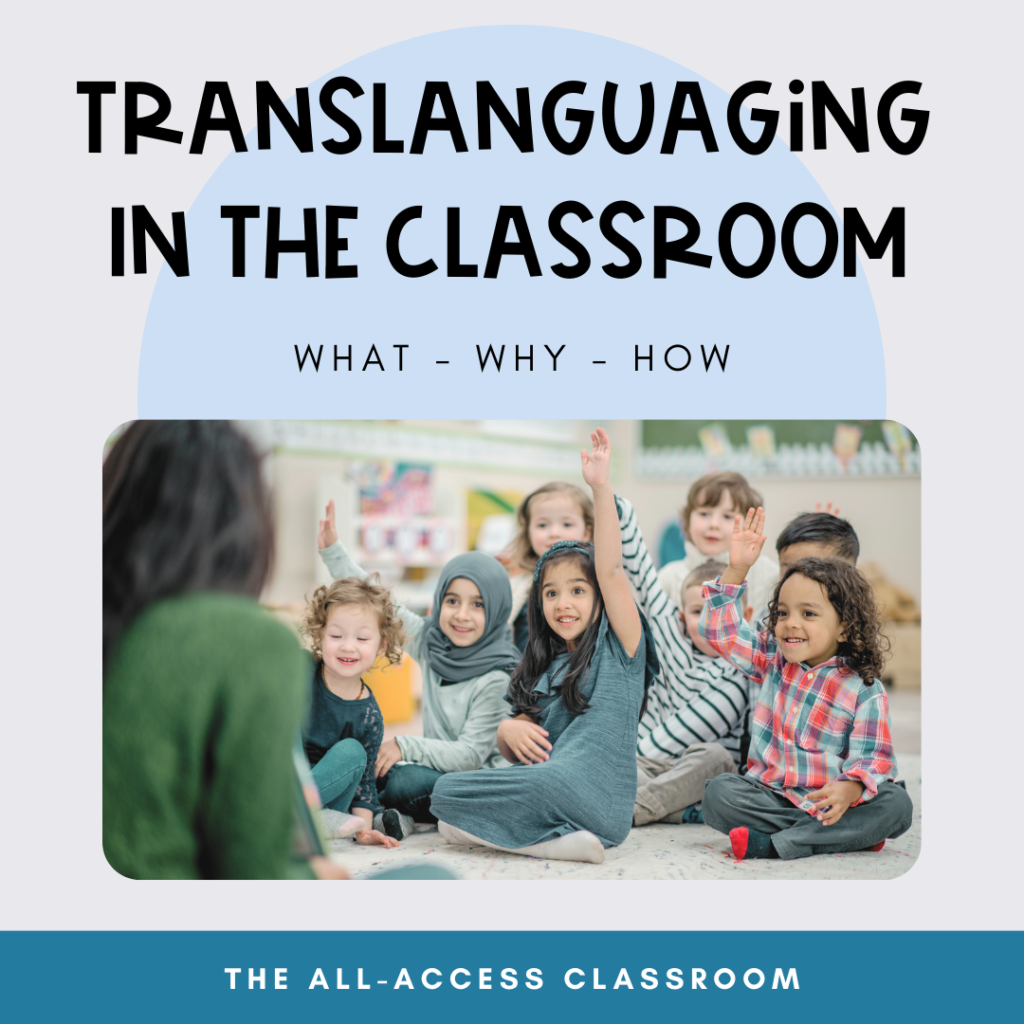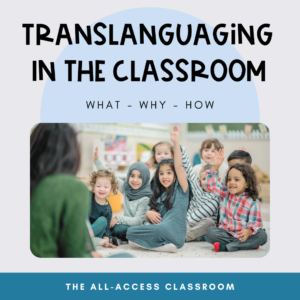If you’re an educator committed to supporting language growth and equity for multilingual learners, translanguaging may be one of the keys to your success. In this article, I’ll introduce you to translanguaging, its benefits in the classroom, and how you can leverage it within your teaching practice.
I remember one of my first trips to Latin America. My little sister and I visited Alajuela, Costa Rica. We were there to do volunteer work for the summer, teaching English in a local school. We stayed with a host family whose dominant language was Spanish.
My sister and I were just beginning to acquire Spanish, and so we were met with the expected challenges. From navigating the transportation system, to reading menus, to figuring out how to tell our host parents that there was a tarantula in our bedroom, we had constant language barriers to overcome.
How did we make it through and learn how to navigate this new place? What helped us interpret and express what was needed? What was even more helpful than our pocket dictionaries? Translanguaging.
What Does Translanguaging Mean?
Translanguaging occurs when a person utilizes features from more than one language to negotiate meaning or communicate within a single context. Languages blend and combine in a dynamic way. Research shows us that new languages develop in concert with, not compartmentalized from, existing foundational language. The brain needs to be able to fluidly refer to all linguistic assets as it constructs new features of communication.
Translanguaging in Various Settings
We may observe translanguaging happening spontaneously in social contexts, as two bilingual people converse using both languages in order to communicate information or increase clarity.
So my sister and I used translanguaging in Costa Rica when:
- One of us would clarify the meaning of a Spanish word or phrase to the other
- We would be talking with our host family, and turn to each other to confirm that we were understanding the conversation correctly
- We had a conversation about pop culture with the teenage daughter of the host parents, using both English and Spanish
In the academic setting, translanguaging pedagogy can provide a guided process in which students draw from multilingual resources to maximize learning. Learners build bridges from their dominant language practices to those of academic English. For teachers, this could include giving students structured opportunities to:
- Receive content-area input in both languages
- Engage in peer discourse in one or both languages
- Make explicit connections in a way that supports acquisition of new learning and vocabulary
- Create a learning artifact that demonstrates content understanding, utilizing both languages, as needed
Learning how to guide students in productive translanguaging is a process. It requires a certain balance, as well. Of course, we want students to maintain growth in academic English acquisition. At the same time, we don’t want to force the compartmentalization or limitation of languages that might be super helpful for learning. It’s all about intentional planning and purposeful implementation.
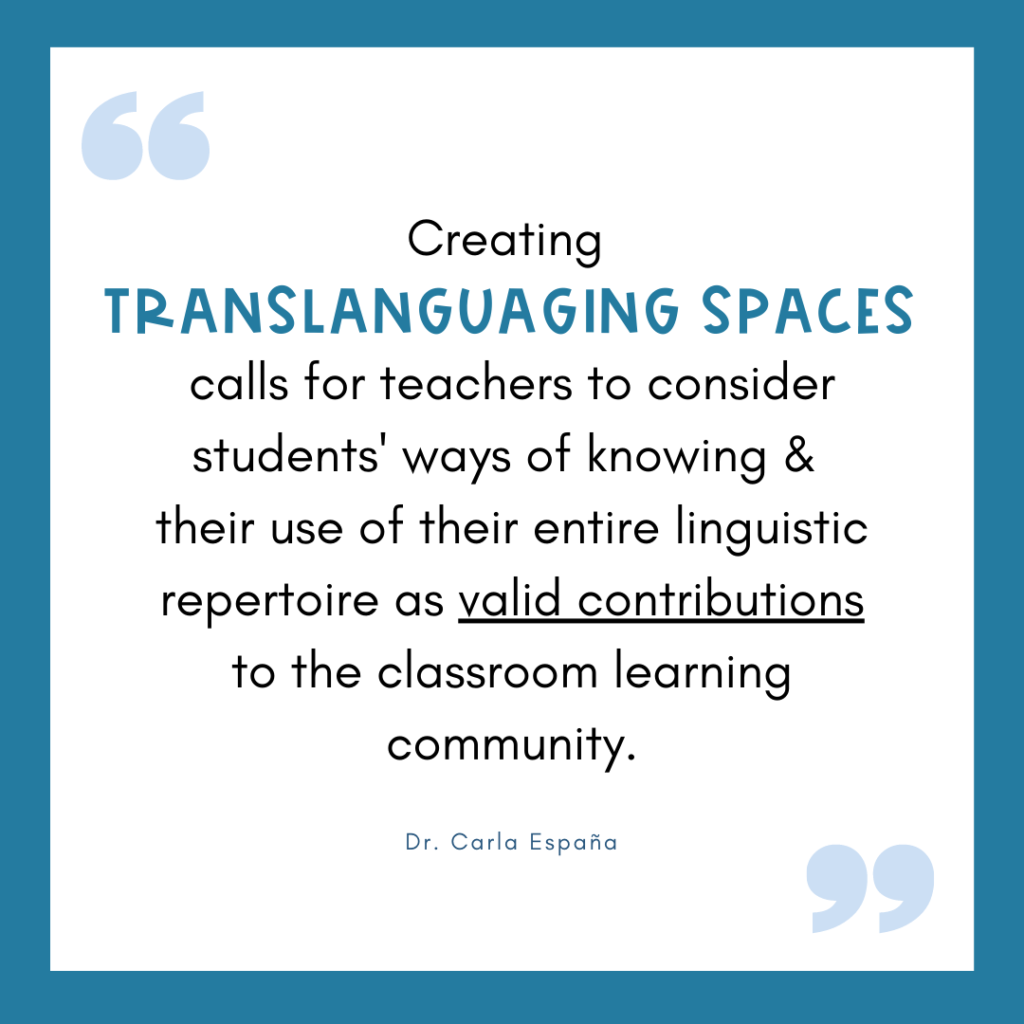
Benefits of Multilingual Learning Environments Where Students are Invited to Translanguage
There are a multitude of amazing benefits that come when learners are empowered to translanguage:
- Students are given the freedom to express themselves and take pride in their primary language.
- The learning community experiences a shift toward equity and inclusion for linguistically diverse students, as multilingualism is celebrated as a useful and desirable asset.
- Multilingual learners have an increased sense of belonging and are able to contribute/add value to classroom activities.
- All students in the classroom have increased exposure to multiple languages, preparing them for success in our diverse global society and workforce. (Over half of Earth’s population is multilingual!)
- MLs are more likely to comprehend, analyze, and interpret content-area texts and materials.
- MLs are more likely to participate in peer, group, and class oral discourse.
- Assessment of content learning may be more accessible and equitable.
One of the benefits of multilingual learning experiences that I love the most is that it will allow students’ linguistic identities to be affirmed, rather than stifled…Activated, rather than ignored. Individuals can fully come to life when their language can “breathe.”
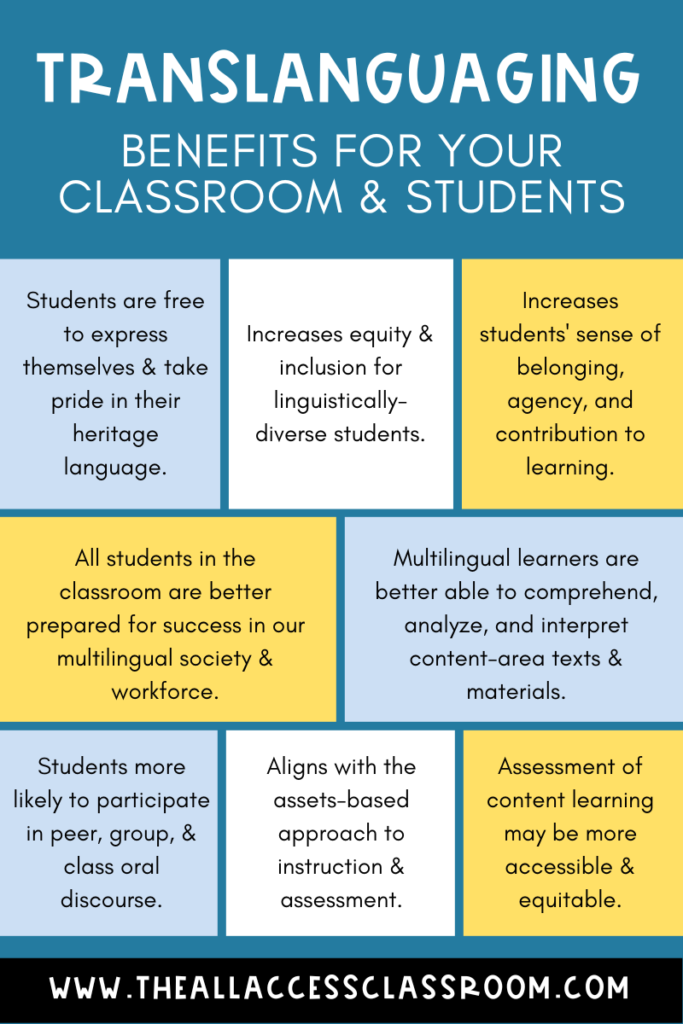
Leading Multilingual Learners into Guided Translanguaging Opportunities (even if you don’t speak their language!)
Let’s talk about practical ways you can invite students to translanguage to enhance the learning experience. Keep in mind that if structured appropriately, these methods will maintain a sense of purpose and intentionality. They will be a constructive use of lesson time, and will remain grounded by academic objectives and explicit teacher direction. Even if the teacher does not speak the languages represented in the classroom, translanguaging can be successful.
Some things that are strongly recommended before diving into translanguaging practices:
- An asset-based, culturally-sustaining classroom, where all learners’ differences are valued and given a safe space to blossom
- Patience and perseverance, as students need time to grow comfortable, confident, and accustomed to class routines and expectations for activities. It takes time for any routines to become established in a classroom.
- For monolingual teachers, a bit of courage, and even being okay with potential discomfort at first, when unable to understand student communications. The emphasis must be on students making meaning, in whatever language they are able to do so. You can have fun being an emergent bilingual alongside them, taking the stance of being a lifelong learner yourself! 🙂 It’s okay to rely on translation tools–and the students–to help you interpret and engage with translanguaging students.
Ready to introduce translanguaging opportunities into lessons? Let’s take a look at some options and examples.
Translanguaging Examples in the Classroom Setting: 5 Approaches
I always enjoy making the shift from theory to practical strategies which you may implement in your teaching context. So here are 5 possible approaches, with translanguaging examples in the classroom setting:
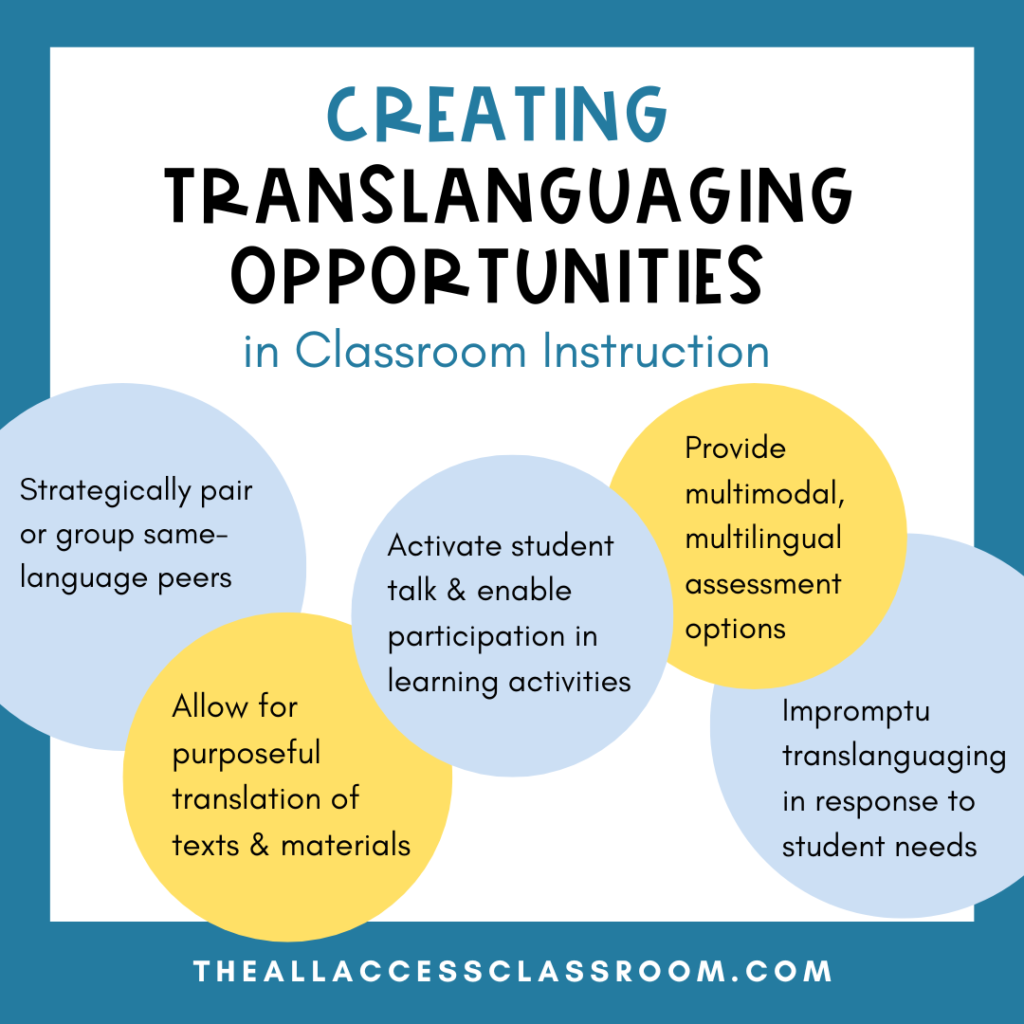
1. Strategic pairing and grouping of students
- Example: You have established a routine for peer discussion or “turn and talk” during whole-group lessons. You intentionally place or partner same-language students together, and offer them the opportunity to translanguage as part of the discussion routine.
- Example: You have the second language (L2) version of a chapter book or text available. As the class is directed to read a portion of the book, you position same-language peers so that they may read the L2 version together.
2. Tapping into multilingual literacies through content-area texts and materials
- Example: You have planned to show a short video as part of your content lesson, and you have one student in the class whose dominant language is other than English. You know he will have a difficult time accessing the video presentation. You locate a video on the same subject matter in his L1, and give him opportunities to view this prior to the lesson.
- Example: Your “big box” ELA curriculum includes Spanish versions of the texts for each lesson. Some of your students have Spanish L1 literacy, while others have had interrupted education, and are not able to read it. You allow these students to read the text in a small group, with those who are able reading it aloud in Spanish. As the lesson progresses, you ensure that these students have access to both versions of the text, so that they can reference and make meaning from the two.
3. Activating student talk
- Example: You are about to guide students in a time of partner or small-group discussion, in which they will respond to a prompt or essential question. You provide a couple of sentence starters, and explain that you’d like to hear students using the sentence starters as they share their ideas. You also display the sentence frame (using Google Translate) in some students’ L2, and say that they are welcome to translanguage as they share their ideas. (Be sure to group them strategically, so that monolingual students aren’t excluded from discussion.)
- Example: Establish a word/phrase of the day, in which a student teaches the rest of the class a helpful word or phrase in their L1. Encourage students to practice and apply new words or vocabulary throughout their day.
4. Multimodal, multilingual assessment options
Whether writing or speaking, some students may benefit from being able to initially produce or express academic ideas in their L1. This product may be assessed as is. It can also serve to launch them into a scaffolded English-language assessment activity.
- Example: Students are writing a personal narrative. You have a newcomer with strong L1 literacy, and would like to give them the opportunity to freely express their story. You enable them to do so in their L1 first, and they submit a version in both languages. You work with the ML specialist to guide the student in a lesson in which they recreate the narrative. They might label pictures of the narrative events, or co-construct simple sentences, based on the student’s English proficiency level.
- Example: A team of students is about to present to the class the outcome of their science experiment. Part of students’ grade is based on participation. You enable multilingual learners to language freely and flexibly throughout the experiment. For the presentation, you allow them to share their part/ideas/input using their L1. (They may speak, if they are confident to do so, or write, and translate as needed for the class to understand what is shared).
5. Impromptu translanguaging to respond to student needs
- Example: You are working together as a class to solve a math problem, and one student has found a solution. If they are bilingual themselves, you may invite them to share their process/thinking in both English and their other language. Or, you have another student listen to the explanation, then repeat it in the L2.
- Example: You are sharing new information on a topic, and have a sense that a key content term being used might have a Spanish cognate. You don’t know much Spanish, and are unsure, but you refer to a Spanish-speaking student to translate, share from their background knowledge, or look up the translation. (We love a little on-the-fly bilingual sparkle in a lesson!) 🙂
These are just some translanguaging examples, to give you a sense of what this might look like for you and your learners. Do you have any additional examples or ideas? Please share in the comments!
Tips for Implementation:
- Introduce the class to the definition of translanguaging
- When you are preparing students for a learning activity where translanguaging will be encouraged, signal to them or directly state your intentions/expectations/hopes for the activity.
- Remind students of tools and resources they may utilize.
- You may wish to model for students what translanguaging may look like for a particular activity, especially if they are not accustomed to a linguistically-inclusive learning environment.
- Remain very open and observant, responding to individual student needs and preferences, rather than relying on assumptions. Adjust your expectations accordingly.
One final encouragement:
It’s a great idea to start small. Translanguaging in the classroom is meant to be purpose-driven. It’s meant to be guided by the intentional, supportive structure provided by the teacher. The better you know your students, the more confident you will be as you guide them.
And if you’ll humor me…some analogies (I love a good analogy!)
Just as an artist selects each color and each brushstroke to create something wonderful…Your students’ linguistic palettes are ready for action, if you’re willing to let them use all their tools to bring about new learning!
Let’s say someone gets injured and needs immediate transportation to the hospital. Does it matter to you whether someone drives them by car, motorcycle, or airplane, as long as the vehicle gets them to the desired destination? No, because the objective is what’s most important.
Let’s say you’re volunteering to build a house with Habitat for Humanity. You’re grooving right along with your electric nail gun, and your friend shows up with a hammer. Of course, you invite them to build with you, using the tool they brought. In the end, the house will get built through collective effort!
Thank you for the good work you do to craft equitable learning experiences for your students! All the best,

Side note: I know there are some schools that have policies that prohibit or discourage translation or inclusion of languages other than English…So please receive and use this information in whatever way seems fitting or appropriate for your current context…(and consider advocating for change!)
For more on translanguaging, check out:
What is Translanguaging? (Heinemann Blog)
Rooted in Strength: Using Translanguaging to Grow Multilingual Readers and Writers, by Laura Ascezni-Moreno and Cecilia Espinoza
A Pedagogy of Translanguaging (Language Magazine)
Translanguaging: A CUNY-NYSIEB Guide for Educators, by C. Celic and K. Seltzer
The Translanguaging Classroom: Leveraging Student Bilingualism for Learning, by O. Garcia, et al.
Honoring Language Assets – Whitepaper by Ellevation
You might also like:
3 Impactful Ways to Support ELLs When Teaching: Scaffolding Strategies
3 Important Considerations for Class Placement, Seating, and Grouping ELL Students in the Classroom

